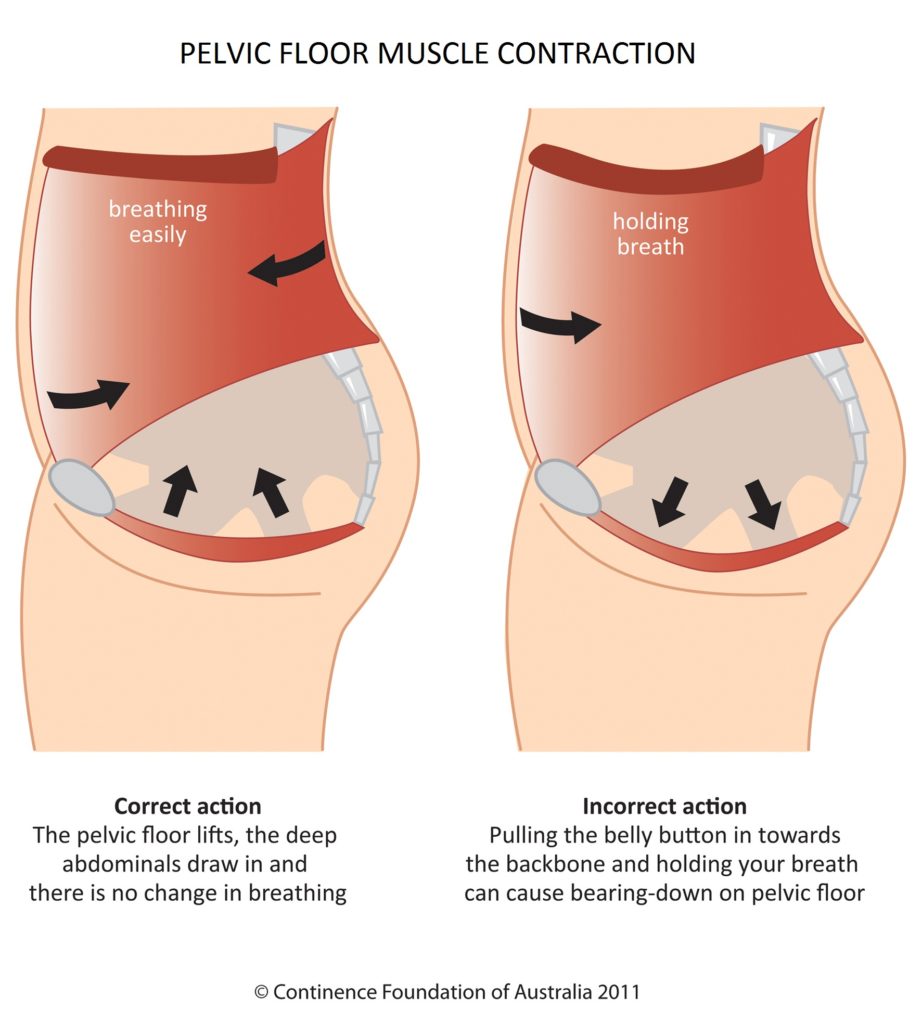The pelvic floor is a group of muscles and ligaments that support the bladder, uterus (womb) and bowel. It is part of what is commonly known as the ‘core.’
The 4 main muscles of the core are:
- Pelvic floor, (hammock or a sling, and that supports the bladder, uterus, prostate, and rectum, it is attached to the bony pelvis),
- Transverse abdominal (“corset” type muscle wrapping around the waist area),
- Multifidus (long thin muscle connecting to each vertebra in the spinal column),
- Diaphragm (main muscle of respiration).
Therefore when we work to stabilize the muscles of the core or rather the trunk, we learn that if we don’t “brace” the core muscles, our lower back takes a beating.
Those of you who practice Pilates will recognize the core stabilizing technique of breathing in as you press your navel to the spine, this technique is called hollowing.
However, in real life, we are mainly in a vertical position, and the core muscles may not be able to translate the hollowing technique to protect the spine sufficiently.
When we are working to strengthen the pelvic floor during our active exercises, we are learning to “brace” or slightly pull up and in, the muscles of the pelvic floor. Thereby providing a base of support for the internal organs during movement.
Technically, we should only exercise to the strength and mobility of our pelvic floor; this means we must learn to “turn on” the pelvic floor muscles (strength) and learn how to relax them too (mobility).
Therefore, pelvic floor dysfunction is not just about weak pelvic floor muscles (Hypotonicity), it can be also tight pelvic floor muscles (Hypertonicity).
It is important to remember that the classic signs of a dysfunctional pelvic floor (i.e., accidental leaking) is not a normal part of aging.
If you suspect a pelvic floor dysfunction, then please see an appropriate continence professional for proper diagnosis.
Engaging your pelvic floor
Abdominal bracing is a good technique to use as part of your workout because it allows you to prime your body for exercise.
Abdominal bracing is tensing the muscles of the truck (including the pulling up of the pelvic floor) as if you are about to be punched in the stomach. It’s not holding your breath or sucking in your tummy.
Bracing will automatically pull in your stomach and activate all the layers of abdominal muscles along with the obliques (side muscles) and muscles deep in the lower back.
If you are not sure what I mean by bracing; stand tall with good posture, feet shoulder-width apart, take a deep breath making sure that your belly inflates as you breathe in. Tighten your abdominal muscles slightly while lifting your pelvic floor, keep this tension and breathe out.
In the braced position you should be able to breathe naturally and still feel stable and strong on your feet. If I were to give you a little nudge you should be able to hold your position.
Abdominal bracing is often used in yoga, and if you have the technique right – you will be able to stand firm on one leg and still breathe – very challenging for me!
Here is a diagram from Continence Foundation of Australia that may help illustrate what I mean:

Abdominal bracing as a metaphor for life
There are so many things in life that are beyond our personal control. We may choose to slump and be defeated by the “unfair” or the “why me.”
We may have been taught that it is a virtue to “suck it up” that is, put up with the unpleasant situation without complaining. Unfortunately, this is not the best strategy for mental or physical health.
Building core strength through active exercising gives you clarity of mind, with a sense of purpose that allows you to react to life with compassion for yourself and those around you.
Bracing your abdominal muscle and strengthening your body gives you the power to change your life for the better – forever!
If you are ready to embrace your fitness then perhaps our 9 minutes to fitness program is the answer for you. Click below for more information and to download your Free 9 minute workout.
Live well with fitness!



Recent Comments